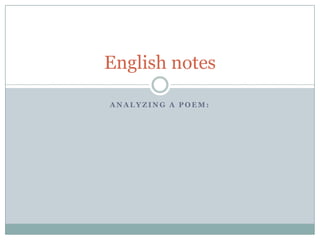
English notes
- 1. English notes ANALYZING A POEM:
- 2. What the poem does: What does poem do? Expresses the poet‟s feelings Creates feelings in the reader. Makes the familiar unfamiliar , and thereby draws our attention to the ideas and feelings the poet wishes to share.
- 3. Effects of poem What is the purpose of poetry? To persuade To make us look differently at familiar things and ideas To shock To amuse To entertain To experiment To make us understand Most of all, a poem seeks to express and create an EMOTION. Our task is to find out HOW.
- 4. Poetic techniques How does a poem work? We need to discover what the “engine parts” of the poem are. We usually refer to these engine parts as “poetic techniques”. Then we need to find out how these techniques make the poem “work”. In other words, or task is to show how technique makes meaning. Like an engine, a poem has components that make it work.
- 5. Poetic techniques Can be roughly grouped this way: Language (diction, syntax, repetitions and patterns, titles, figurative language) Sound effects Contexts and traditions.
- 6. Language (diction, syntax, repetitions and patterns, titles, figurative language) Sound effects Contexts and traditions.
- 7. Imagery Types of Imagery Symbol: reference to two, often commonly associated things Simile: two things compared, using the phrase „as … as‟ or the word „like‟. Metaphor: comparison of two dissimilar things
- 8. Sound effects Sound effects are created by: RHYTHM Rhythm is created by: repetition, stressed and unstressed syllables, punctuation. The purpose of rhythm is to provide unity and coherence; to fulfill or defeat expectations; and to create a mood or feeling. It is in its use of rhythm that poetry most resembles music
- 9. RHYME Two or more words that sound alike, usually, (but not always) at the end of a line. The function of rhyme is to create unity, to join ideas or concepts together.
- 10. Repetition of WORD-SOUNDS A poet can put the sounds of words to good effect, especially if their sound imitates the thing they are describing.
- 11. PUNCTUATION Punctuation (commas, full stops, exclamation marks, semi-colons, etc) can often affect the pace of a line of poetry. Absence of punctuation can create a smooth, flowing effect. An abundance of punctuation can have the opposite effect.
- 12. Contexts and traditions What historical events have a bearing on the poem? Context Who wrote this poem? What historical events have a bearing on the poem? Who is reading this poem?
- 13. Traditions What form does the poem take? Poems can take the form of, for example, a sonnet, or a lyric, or a dramatic monologue. Does the form of the poem affect our understanding of it? (Note: we expect certain forms of poetry to do specific things)
